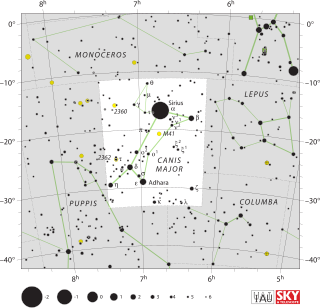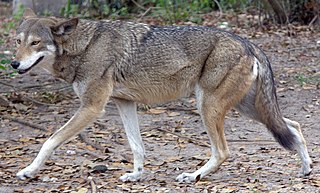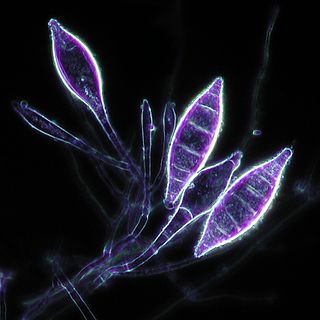
Canis Major is a constellation in the southern celestial hemisphere. In the second century, it was included in Ptolemy's 48 constellations, and is counted among the 88 modern constellations. Its name is Latin for "greater dog" in contrast to Canis Minor, the "lesser dog"; both figures are commonly represented as following the constellation of Orion the hunter through the sky. The Milky Way passes through Canis Major and several open clusters lie within its borders, most notably M41.

Canis Minor is a small constellation in the northern celestial hemisphere. In the second century, it was included as an asterism, or pattern, of two stars in Ptolemy's 48 constellations, and it is counted among the 88 modern constellations. Its name is Latin for "lesser dog", in contrast to Canis Major, the "greater dog"; both figures are commonly represented as following the constellation of Orion the hunter.

The coyote is a species of canine native to North America. It is smaller than its close relative, the wolf, and slightly smaller than the closely related eastern wolf and red wolf. It fills much of the same ecological niche as the golden jackal does in Eurasia. The coyote is larger and more predatory and was once referred to as the American jackal by a behavioral ecologist. Other historical names for the species include the prairie wolf and the brush wolf.

There are 38 subspecies of Canis lupus listed in the taxonomic authority Mammal Species of the World. These subspecies were named over the past 250 years, and since their naming, a number of them have gone extinct. The nominate subspecies is the Eurasian wolf.

Jackals are medium-sized canids native to Africa and Eurasia. While the word "jackal" has historically been used for many canines of the subtribe canina, in modern use it most commonly refers to three species: the closely related black-backed jackal and side-striped jackal of sub-Saharan-Africa, and the golden jackal of south-central Europe and Asia. The African golden wolf was also formerly considered as a jackal.

The red wolf is a canine native to the southeastern United States. Its size is intermediate between the coyote and gray wolf.

The dire wolf is an extinct canine. It is one of the most famous prehistoric carnivores in North America, along with its extinct competitor Smilodon. The dire wolf lived in the Americas and eastern Asia during the Late Pleistocene and Early Holocene epochs. The species was named in 1858, four years after the first specimen had been found. Two subspecies are recognized: Aenocyon dirus guildayi and Aenocyon dirus dirus. The largest collection of its fossils has been obtained from the Rancho La Brea Tar Pits in Los Angeles.

Canis is a genus of the Caninae which includes multiple extant species, such as wolves, dogs, coyotes, and golden jackals. Species of this genus are distinguished by their moderate to large size, their massive, well-developed skulls and dentition, long legs, and comparatively short ears and tails.

The dusky smooth-hound, also called the smooth dogfish or the dog shark, is a species of houndshark in the family Triakidae. This shark is an olive grey or brown in color, and may have shades of yellow or grayish white. Females live to 16 years and males have a lifespan of 10 years. M. canis was the first shark recognised to have viral infections.

The eastern wolf also known as the timber wolf, Algonquin wolf or eastern timber wolf, is a canine of debated taxonomy native to the Great Lakes region and southeastern Canada. It is considered to be either a unique subspecies of gray wolf or red wolf or a separate species from both. Many studies have found the eastern wolf to be the product of ancient and recent genetic admixture between the gray wolf and the coyote, while other studies have found some or all populations of the eastern wolf, as well as coyotes, originally separated from a common ancestor with the wolf over 1 million years ago and that these populations of the eastern wolf may be the same species as or a closely related species to the red wolf of the Southeastern United States. Regardless of its status, it is regarded as unique and therefore worthy of conservation with Canada citing the population in eastern Canada as being the eastern wolf population subject to protection.
The Canis Major Overdensity or Canis Major Dwarf Galaxy is a disputed dwarf irregular galaxy in the Local Group, located in the same part of the sky as the constellation Canis Major.

The black-backed jackal, also called the silver-backed jackal, is a medium-sized canine native to eastern and southern Africa. These regions are separated by roughly 900 kilometers.

The golden jackal, also called common jackal, is a wolf-like canid that is native to Southeast Europe, Southwest Asia, South Asia, and regions of Southeast Asia. The golden jackal's coat varies in color from a pale creamy yellow in summer to a dark tawny beige in winter. It is smaller and has shorter legs, a shorter tail, a more elongated torso, a less-prominent forehead, and a narrower and more pointed muzzle than the Arabian wolf. It is listed as Least Concern on the IUCN Red List due to its widespread distribution and high density in areas with plenty of available food and optimum shelter.

Peptostreptococcus is a genus of anaerobic, Gram-positive, non-spore forming bacteria. The cells are small, spherical, and can occur in short chains, in pairs or individually. They typically move using cilia. Peptostreptococcus are slow-growing bacteria with increasing resistance to antimicrobial drugs. Peptostreptococcus is a normal inhabitant of the healthy lower reproductive tract of women.

Microsporum canis is a pathogenic, asexual fungus in the phylum Ascomycota that infects the upper, dead layers of skin on domesticated cats, and occasionally dogs and humans. The species has a worldwide distribution.
Peptostreptococcus anaerobius is a species of bacteria belonging to the Peptostreptococcus genus of anaerobic, Gram-positive, non-spore forming bacteria. The cells are small, spherical, and can occur in short chains, in pairs or individually. Peptostreptococcus are slow-growing bacteria sometimes resistance to antimicrobial drugs.
Finegoldia is a genus of Gram-positive bacteria. They are anaerobic cocci of the class Clostridia, with Finegoldia magna being the type species. F. magna was formerly known, along with several other Gram-positive anaerobic cocci (GPACs), as Peptostreptococcus magnus, but was moved into its own genus in 1999. The name is in honor of Sydney M. Finegold, an American microbiologist, while magna is Latin for large. It is an opportunistic human pathogen that normally colonizes skin and mucous membranes. It is often seen in biofilms on chronic ulcers such as in diabetic foot or decubitus ulcers. Most surveys have found it to be susceptible to penicillins, carbapenems and metronidazole, though resistant strains have been identified. Resistance to clindamycin is common and has been seen in over 10% of isolates in the US. One review stated that "the combination of diminished antimicrobial susceptibility, its prevalence, and the described virulence factors gives F. magna a special position among the GPAC."

Lupulella is a genus of canine found in Africa. This genus consists of only two extant species, the black-backed jackal and the side-striped jackal.
Peptostreptococcus porci is a bacterium from the family Peptostreptococcaceae.














